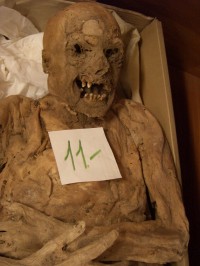Mutations of the Adenomatous polyposis coli (APC) gene associated with the developement of colorectal tumors are common in the modern population, but because lifestyle and environmental factors like obesity, physical inactivity and chemical exposure prevalent today contribute to cancer rates, human remains from earlier times in history provide a unique insight into the evolution of disease. With soft tissue diseases like colorectal cancer, it’s difficult to find evidence in remains most of which are skeletal.
 Mummies can bridge the gap, especially natural mummies with surviving tissue that was not embalmed. The mummies of more than 265 people buried in the crypt of the Church of the Whites in Vác, Hungary, between 1731 and 1838 have already proven a boon to medical research. The crypt was bricked in decades ago and forgotten until it was rediscovered by construction workers in 1994. The steady, cool temperature, continual low-level ventilation and the anti-microbial and moisture-absorbing properties of the pine shavings in the coffins created a perfect storm of preservation. There’s also extensive surviving archival information about the people buried in the crypt, which gives researchers valuable information about familial relations, professions, age, dates, etc.
Mummies can bridge the gap, especially natural mummies with surviving tissue that was not embalmed. The mummies of more than 265 people buried in the crypt of the Church of the Whites in Vác, Hungary, between 1731 and 1838 have already proven a boon to medical research. The crypt was bricked in decades ago and forgotten until it was rediscovered by construction workers in 1994. The steady, cool temperature, continual low-level ventilation and the anti-microbial and moisture-absorbing properties of the pine shavings in the coffins created a perfect storm of preservation. There’s also extensive surviving archival information about the people buried in the crypt, which gives researchers valuable information about familial relations, professions, age, dates, etc.
Last year a study found 12 different strains of tuberculosis in DNA extracted from the Vác mummies. Now a new study has found a genetic predisposition to colorectal cancer in one of the mummies.
The researchers used genetic sequencing to identify mutations in APC genes that were isolated from the mummies. “Mummified soft tissue opens up a new area of investigation,” Prof. Hershkovitz says. “Very few diseases attack the skeleton, but soft tissue carries evidence of disease. It presents an ideal opportunity to carry out a detailed genetic analysis and test for a wide variety of pathogens.”
“Our data reveal that one of the mummies may have had a cancer mutation. This means that a genetic predisposition to cancer may have already existed in the pre-modern era,” Dr. Sklan says. “But we’ve found this mutation in only one individual so far. Additional studies with a larger sample size should be conducted in order to draw more meaningful conclusions.”
The discovery of the gene doesn’t mean the individual ever had colon cancer, of course. While very well preserved, the sample was still desiccated and, well, mummified, so researchers weren’t able to distinguish tumors from normal colon tissue.
This is an important breakthrough in the analysis of ancient DNA and the study of the evolution of disease. Until now, ancient DNA studies have primarily focused on extracting the DNA of pathogens. This is the first published study to report the presence of cancer or mutations association with cancer in the DNA. Research on ancient cancer has had to make do with bone lesions and microscopic evidence.
The study has been published in the journal PLoS ONE and can be read free of charge here.